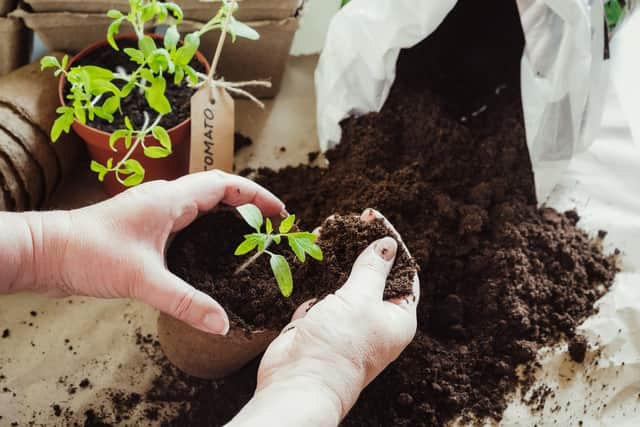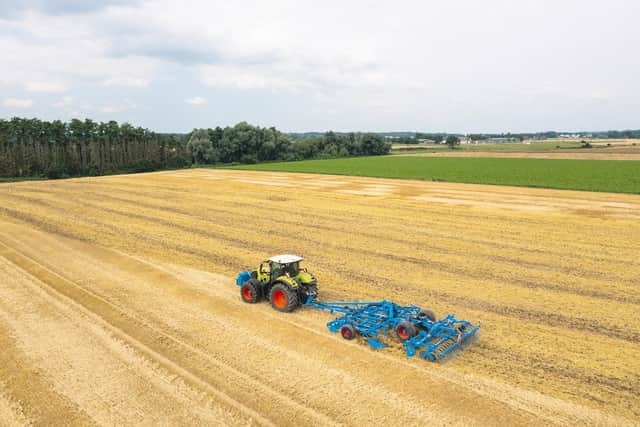Soil fertility: it’s all about keeping the P and K values at the right level
and live on Freeview channel 276
So, here comes the fundamental fact: without soils, there would be neither farming nor food production taking place anywhere in the world.
As a consequence, understanding the core functionality of our soils is key to managing them on a sustainable basis.
Advertisement
Advertisement
Professor Mike McLaughlin – originally from Co Antrim- is now working as a research professor at the University of Adelaide in Australia.


He explained that clay, silt, sand and organic matter are the solid components of soil, adding:
“Clays are important because they have a lot of the nutrient holding and water capacity within any soil.
“Similarly, the organic fraction within soil contains high levels of nutrients.
Advertisement
Advertisement
“It’s the interaction of clay with the sand, silt and organic fractions that determines the fertility of soil in both a physical and chemical sense.”


According to McLaughlin, if any of these components are taken away, problems will follow in terms of agricultural production.
“It really is a team activity in soils,” he said.
“Clays are critical: they are very small particles, which means they have a very large surface area and charge.
“This helps to maintain nutrients within soils and prevent leaching.”
Advertisement
Advertisement
The organic matter in soils comes from the original vegetation that was on the land.
McLaughlin continued:“We also add organic matter to soils. When a crop is grown, up to 50% of the associated carbon is found below ground.
“In the case of 12t/ha wheat crop with its associated straw, there is in the region of 12 to 15t of carbon biomass growing below ground as well.”
“There is a huge throughout of carbon within agricultural systems that we forget about.”
Advertisement
Advertisement
McLaughlin went on to point out that agricultural production systems actively put carbon into soils.
“It’s the tillage-related operations that we have to be careful about as these activities tend to mineralise the organic matter,” he further explained.
Turning to the issue of pH, McLaughlin stressed that alkalinity or acidity is the master variable within soils.
“This factor alone controls the availability of so many nutrients for crop growth,” he commented.
Advertisement
Advertisement
“Soil pH also controls the activity of microorganisms in soil.”
Why are soil pH values so important?
When soil H values are low, clay is actually dissolved. This leads to problems from an agricultural point of view.
According to Professor McLaughlin, the soil clay fraction is made up of aluminosilicate minerals or aluminium hydroxide.
He added:“In very acid soils, the clay mineralogy is broken down.
Advertisement
Advertisement
“As a result, two things can happen: aluminium moves out of the soil and/or the free aluminium can add to the toxicity of the soil.
“In either case a leaching of the soil’s clay fraction takes place.
Professor McLaughlin took part in the most recent issue of the Tillage Edge podcast.
He pointed out that low pH values change the charge patterns on soil particles, involving the clay and the organic matter, adding:
“This can impact on how the soil holds nutrients.
Advertisement
Advertisement
“Acid soils, in particular will bind phosphorous very strongly. This is because of the very active aluminium.
“They will also bind a number of micro elements, including molybdenum, which is important for nitrogen fixation.”
McLaughlin explained that soils should not be too acidic or too basic.
“On the alkaline side, problems associated with trace element availability will arise,” he commented.
Advertisement
Advertisement
“Those with a strong positive change, including copper, manganese and zinc, will have a problem in alkaline soils because they get bound up very strongly, as does phosphorous.
“So, at the two ends of the pH spectrum, issues with regard to nutrient availability will arise.
McLaughlin also confirmed that microorganisms are not very happy when soil conditions are either very acidic or basic.
He said:“The objective should be to keep soil pH values in the mid-band range of 5.5 to 7.5.
“This is the sweet spot for pH.”
Advertisement
Advertisement
In the case of soils with pH values that exceed a value of 7.0, McLaughlin indicated that farmers should evaluate the various forms of phosphate fertiliser available to them.
He pointed out that diammonium phosphate (DAP) undergoes a very alkaline type reaction in the soil when first applied. However, conditions very quickly turn acidic because the freed ammonia is converted to nitrate.
“In a very alkaline soil, this is good because it brings the pH value back towards the sweet spot,” he explained.
“Triple super phosphate, on the other hand, is acidic to start with. Primarily this is because of the residual phosphoric acid in the granules.
Advertisement
Advertisement
“But then it becomes quite alkaline over time. There is a lot of calcium in the soil and calcium in the product, this can reduce the diffusion of phosphorous a little bit.
“Overall, it has been shown that adding DAP can be beneficial for crops. There is a synergy between the phosphorous and the nitrogen.
“The ammoniated phosphates tend to do better than triple super phosphate, which is basically calcium phosphate.
“However, triple super phosphate is preferred when growing legumes. One of the unfortunate things with phosphorous is that, when applied as a fertiliser, binding with the soil increase with time, particularly within low fertility scenarios.”
Advertisement
Advertisement
“So we do have to build up a soil phosphorous bank. Phosphorous binding is reversible, up to a point, over a number of years.
“So, over time farmers do get some of the phosphorous that was applied as fertiliser back from a plant growth perspective.”
Soil testing is critical
Regular soil testing is critical when it comes to determining P availability, according to Professor McLaughlin, a research scientist at Adelaide University in Australia.
He added:“If a high soil test value comes back and the land in question is n the top phosphorous tier, there is probably no need to apply fertiliser P. But soils in the very lowest tier will need a fair chunk of added fertiliser, in order to get crops up to their full yield potential.
Advertisement
Advertisement
“The reason for soil testing is to get a measure of phosphorous availability from previous fertiliser applications.”
According to McLaughlin, a lot of farmers are not adding phosphorous to soils because of the cost involved.
He further explained:“If this went on for decades, soil P test results would slowly decline.
“And crop yields would also decline in step with this trend.”
Measuring plant potassium
Advertisement
Advertisement
Meanwhile, the Potash Development Association (PDA) is highlighting the benefits to be accrued by actually measuring the potassium (K) concentrations of growing crops.
In a lot of cases, farmers may base their K requirements based on the needs of a growing crop only. This would assume that the field, or fields, in question had previously been confirmed as Index 2 for this crop nutrient, based on a soil test result.
But according to the PDA, this one-off assessment may need monitoring to ensure this remains the case for each specific soil type and across the years between sampling and even within fields.
Any in-field tests for K sufficiency should meet a number of basic requirements. These are: it is easy and inexpensive to carry out and it gives a definitive answer on sufficiency/deficiency
Advertisement
Advertisement
In addition, the timing of measurement and turnaround time gives growers the opportunity to respond. And, finally, the testing should allow management practices that give a high level of successes.
The most basic method for monitoring potassium levels and identifying deficiency would be through a visual assessment.
For nutrients in general, waiting for deficiency symptoms to become visible may be too late as crops can appear to be perfectly well fed yet still be deficient.
When K is deficient, several processes are impaired. Low K inhibits enzyme activation, making plants more susceptible to fungal attack. Impaired stomatal activity results in poor control over gas exchange, impairing photosynthesis and water control, making plants more susceptible to stresses from drought, frost, water uptake, and soil salinity.
Advertisement
Advertisement
Low K also impairs proton (H+) exchange across membranes in chloroplasts, resulting in worsening symptoms under higher light intensity.
Transport of photosynthates can also be impaired, resulting in a build-up of sugars (potentially worsening aphid attacks) and a reduction in protein and starch synthesis, lowering the plant’s dry weight.
Impaired lignification may result in weaker stalks and increased lodging. Potassium is an abundant cation (K+) found in the cytoplasm, providing cell turgidity and rigidity by maintaining the osmotic potential.
The visual evidence of all these processes may be very difficult to identify, particularly without a sufficiently supplied crop to compare against.
Advertisement
Advertisement
Potassium deficiency may first appear as deep green plants with shorter and fewer internodes and smaller leaves, followed by the rapid development of necrotic spots along the margins and across leaf blades of recently matured leaves.
Potassium deficiency can cause changes in both individual plant organs and, collectively, the crop canopy. When leaf tissue becomes chlorotic or necrotic, it no longer reflects light the same way it did when it was healthy. Visibly, leaves change from green to yellow or brown, but changes also occur outside the visible spectrum.
These changes can be identified by measuring the reflectance of the crop using specific wavelengths which can then be linked back to the potassium status of the plants.
The most common method for identifying deficiencies in crops and grass is tissue analysis, measured by the laboratory on samples collected from the field.
Advertisement
Advertisement
Soil and environmental chemistry, fertiliser formulations and crop nutrition, the behaviour and toxicity of nutrients and contaminants in the soil-plant system, the assessment and remediation of contaminated soils, and use of advanced techniques to measure and monitor nutrients and pollutants in the environment.
However, although tissue analysis is the most common means of measuring nutrient levels in plants, it may not be the most appropriate for potassium, as most K is held in the ‘liquid’ fraction of the plant, not the dry matter.
Another approach to analysing the potassium status of plants is to measure the content of the plant sap. As potassium is held in solution within plants, rather than within the dry matter, sap analysis can be a more accurate method of measuring potassium levels.
Work at Rothamsted Research has indicated that adequacy of potash in winter wheat is represented by tissue water concentration in the first leaf.
Advertisement
Advertisement
Mike McLaughlin is a Professor in the School of Agriculture Food and Wine and Director of the Mosaic-sponsored University of Adelaide Fertiliser Technology Research Centre (http://www.adelaide.edu.au/fertiliser/). He is also a Science Fellow of Australia’s Commonwealth Science and Industrial Research Organisation (CSIRO) Mike gained his B.Sc. from the University of Ulster in Northern Ireland, a M.Agr.Sc from the University of Reading (UK) and his Ph.D. from the University of Adelaide (Australia).
Mike's research interests are principally in soil and environmental analytical chemistry, the behaviour of nutrients and contaminants in soils and the improvement of fertiliser efficiency in agricultural systems.